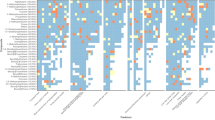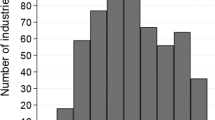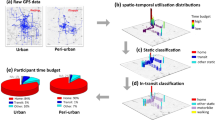Abstract
Classification and regression tree methods represent a potentially powerful means of identifying patterns in exposure data that may otherwise be overlooked. Here, regression tree models are developed to identify associations between blood concentrations of benzene and lead and over 300 variables of disparate type (numerical and categorical), often with observations that are missing or below the quantitation limit. Benzene and lead are selected from among all the environmental agents measured in the NHEXAS Region V study because they are ubiquitous, and they serve as paradigms for volatile organic compounds (VOCs) and heavy metals, two classes of environmental agents that have very different properties. Two sets of regression models were developed. In the first set, only environmental and dietary measurements were employed as predictor variables, while in the second set these were supplemented with demographic and time–activity data. In both sets of regression models, the predictor variables were regressed on the blood concentrations of the environmental agents. Jack-knife cross-validation was employed to detect overfitting of the models to the data. Blood concentrations of benzene were found to be associated with: (a) indoor air concentrations of benzene; (b) the duration of time spent indoors with someone who was smoking; and (c) the number of cigarettes smoked by the subject. All these associations suggest that tobacco smoke is a major source of exposure to benzene. Blood concentrations of lead were found to be associated with: (a) house dust concentrations of lead; (b) the duration of time spent working in a closed workshop; and (c) the year in which the subject moved into the residence. An unexpected finding was that the regression trees identified time–activity data as better predictors of the blood concentrations than the measurements in environmental and dietary media.
This is a preview of subscription content, access via your institution
Access options
Subscribe to this journal
Receive 6 print issues and online access
$259.00 per year
only $43.17 per issue
Buy this article
- Purchase on Springer Link
- Instant access to full article PDF
Prices may be subject to local taxes which are calculated during checkout



Similar content being viewed by others
References
Bonnano L.J., Freeman N.C.G., Greenberg M., and, Lioy P.J . Multivariate analysis on levels of selected metals, particulate matter, VOC, and household characteristics and activities from Midwestern States NHEXAS. Appl Occup Environ Hygiene 2001: 16(9): 1–16.
Bouskila A., Robinson M.E., Roitberg B.D., and, Tenhumberg B . Life-history decisions under predation risk: importance of a game perspective. Evol Ecol 1998: 12: 701–715.
Breiman L., Freidman J.H., Olshen R.H., and, Stone C.J . Classification and Regression Trees. The Wadsworth Statistics/Probability Series. Wadsworth International Group, Belmont, CA, 1984.
Camann D.E., Akland G.G., Buckley J.D., Bond A.E., and, Mage D.T . Carpet Dust and Pesticide Exposure of Farm Children. International Society of Exposure Analysis Meeting, Research Triangle Park, NC, 1997.
Chambers J.M., and, Hastie T.J . Statistical Models in S. Wadsworth and Brooks/Cole Advanced Books and Software. Pacific Grove, CA, 1992.
Clayton C.A., Pellizzari E.D., Whitmore R.W., Perritt R.L., and, Quackenboss J.J . National Human Exposure Assessment Survey (NHEXAS): distributions and associations of lead, arsenic and volatile organic compounds in EPA region 5. J Expos Anal Environ Epidemiol 1999: 9(5): 381–392.
DeFries R.S., Hansen M., Townshend J.R.G., and, Sohlberg R . Global land cover classifications at 8 km spatial resolution: the use of training data derived from Landsat imagery in decision tree classifiers. Int J Remote Sensing 1998: 19: 3141–3168.
Eisenberg J.N.S., and, McKone T.E . Decision tree method for the classification of chemical pollutants: incorporation of across chemical variability and within-chemical uncertainty. Environ Sci Technol 1998: 32: 3396–3404.
Francois C., Remmelink M., Petein M., vanVelthoven R., Danguy A., Wespes E., Salmon I., Kiss R., and, Decaestecker C . The chromatin pattern of cell nuclei is of prognostic value for renal cell carcinomas. Anal Cell Pathol 1998: 16: 161–175.
Friedl M.A., and, Brodley C.E . Decision tree classification of land cover from remotely sensed data. Remote Sensing Environ 1997: 61: 399–409.
Godefroy O., Duhamel A., Leclerc X., SaintMichel T., Henon H., and, Leys D . Brain–behaviour relationships — some models and related statistical procedures for the study of brain-damaged patients. Brain 1998: 121: 1545–1556.
Gordon S.M., Callahan P.J., Wallace L.A., and, Pleil J.D . Continuous Real-time Analysis of Volatile Organic Compounds to Determine Exposure-Dose Relationships. Annual Meeting of SRA/ISEA, New Orleans, LA, 1996.
Lagendijk J.H., Mullink H., VanDiest P.J., Meijer G.A., and, Meijer C.J.L.M . Tracing the origin of adenocarcinomas with unknown primary using immunohistochemistry: differential diagnosis between colonic and ovarian carcinomas as primary sites. Hum Pathol 1998: 29: 491–497.
Lioy P.J., Yiin L.M., Adgate J., Weisel C., and, Rhoads G.G . The effectiveness of a home cleaning intervention strategy in reducing potential dust and lead exposures. J Expos Anal Environ Epidemiol 1998: 8(1): 17–35.
Ö zkaynak H., Xue J., Spengler J.D., Wallace L.A., Pellizzari E.D., and, Jenkins P . Personal exposure to airborne particles and metals: results from the Particle TEAM Study in Riverside, CA. J Expos Anal Environ Epidemiol 1996: 6: 57–78.
Pellizzari E.D., Clayton C.A., Rodes C.E., Mason R.E., Piper L.L., Fort B., Pfeifer G., and, Lynam D . Particulate matter and manganese exposures in Toronto, Canada. Atmos Environ 1999a: 33: 721–734.
Pellizzari E.D., Lioy P., Quackenboss J., Whitmore R., Clayton C.A., Freeman N., Waldman J., Thomas K., Rodes C., and, Wilcosky T . Population-based exposure measurements in EPA region 5: a phase I field study in support of the National Human Exposure Assessment Survey. J Expos Anal Environ Epidemiol 1995: 5(3): 327–358.
Pellizzari E.D., Perritt R.L., and, Clayton C.A . National human exposure assessment survey (NHEXAS): exploratory survey of exposure among population subgroups in EPA Region V. J Expos Anal Environ Epidemiol 1999b: 9(1): 49–55.
Rakowski W., and, Clark M.A . Do groups of women aged 50 to 75 match the national average mammography rate? Am J Prev Med 1998: 15: 187–197.
Rejwan C., Collins N.C., Brunner L.J., Shuter B.J., and, Ridgway M.S . Tree regression analysis on the nesting habitat of smallmouth bass. Ecology 1999: 80: 341–348.
Rhoads G.G., Ettinger A.S., Weisel C.P., Buckley T.J., Goldman K.D., Adgate J., and, Lioy P.J . The effect of dust lead control on blood lead in toddlers: a randomized trial. Pediatrics 1999: 103(3): 551–555.
Roy A., and, Georgopoulos P.G . Reconstructing week-long exposures to volatile organic compounds using physiologically based pharmacokinetic models. J Expos Anal Environ Epidemiol 1998: 8(3): 407–422.
Salzberg S., Delcher A.L., Fasman K.H., and, Henderson J . A decision tree system for finding genes in DNA. J Comput Biol 1998: 5: 667–680.
Seifert B., Becker K., Helm D., Krause C., Schulz C., and, Seiwert M . The German Environmental Survey 1990/1992 (GerES II): reference concentrations of selected environmental pollutants in blood, urine, hair, house dust, drinking water, and indoor air. J Expos Anal Environ Epidemiol 2000a: 10: 552–565.
Seifert B., Becker K., Hoffman K., Krause C., and, Schulz C . The German Environmental Survey 1990/1992 (GerES II): a representative population study. J Expos Anal Environ Epidemiol 2000b: 10: 103–114.
Thiele J., Kvasnicka H.M., Zirbes T.K., Flucke U., Niederle N., Leder L.D., Diehl V., and, Fischer R . Impact of clinical and morphological variables in classification and regression tree-based survival (CART) analysis of CML with special emphasis on dynamic features. Eur J Haematol 1998: 60: 35–46.
Thomas K.W., Pellizzari E.D., and, Berry M.R . Population-based dietary intakes and tap water concentrations for selected elements in the EPA region V National Human Exposure Assessment Survey (NHEXAS). J Expos Anal Environ Epidemiol 1999: 9(5): 402–413.
Wallace L.A . The exposure of the general population to benzene. Cell Biol Toxicol 1989: 5: 297–314.
Weisel C., Yu R., Roy A., and, Georgopoulos P . Biomarkers of environmental benzene exposure. Environ Health Perspect 1996: 104(Suppl. 6): 1141–1146.
Wilson W.H., Zierzow R.E., and, Savage A.R . Habitat selection by peatland birds in a central Maine bog: the effects of scale and year. J Field Ornithol 1998: 69: 540–548.
Acknowledgements
We acknowledge the contribution of Drs. Richard Opiekun and James Quackenboss, for their help in understanding the NHEXAS-V data, and the USEPA for funding the work (NHEXAS Co-operative Agreement CR827713 and EPA University Partnership CR827033). This work was also partly funded by the NIEHS Center at EOHSI (P30ES05022). This work has not yet been subjected to EPA peer review.
Author information
Authors and Affiliations
Corresponding author
Additional information
Environmental and Occupational Health Sciences Institute (EOHSI) is a Joint Program sponsored by UMDNJ- Robert Wood Johnson Medical School and Rutgers University.
Rights and permissions
About this article
Cite this article
Roy, A., Georgopoulos, P., Ouyang, M. et al. Environmental, dietary, demographic, and activity variables associated with biomarkers of exposure for benzene and lead. J Expo Sci Environ Epidemiol 13, 417–426 (2003). https://doi.org/10.1038/sj.jea.7500296
Received:
Accepted:
Published:
Issue Date:
DOI: https://doi.org/10.1038/sj.jea.7500296
Keywords
This article is cited by
-
Biologically based modeling of multimedia, multipathway, multiroute population exposures to arsenic
Journal of Exposure Science & Environmental Epidemiology (2008)
-
Employing dynamical and chemical processes for contaminant mixtures outdoors to the indoor environment: The implications for total human exposure analysis and prevention
Journal of Exposure Science & Environmental Epidemiology (2006)



